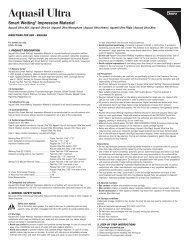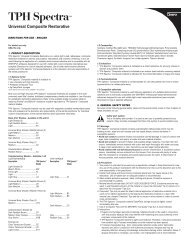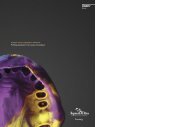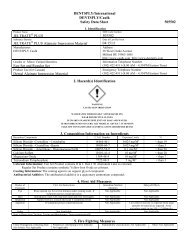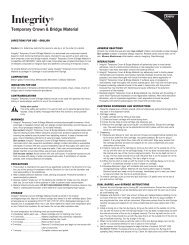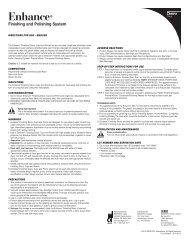Indirect and Direct Restorative Protocols - Caulk
Indirect and Direct Restorative Protocols - Caulk
Indirect and Direct Restorative Protocols - Caulk
Create successful ePaper yourself
Turn your PDF publications into a flip-book with our unique Google optimized e-Paper software.
› PRINCIPLES & PRACTICES<br />
Instrumentation <strong>and</strong> Bur Selection<br />
for Minimally Invasive<br />
Tooth Preparation<br />
› Abstract:<br />
Significant improvements in the oral<br />
health of the worldwide population <strong>and</strong><br />
increasing patient interest in aesthetic<br />
dentistry have resulted in an emphasis<br />
on minimally invasive treatment<br />
options. Conservative treatment of<br />
diseased tooth structures is a valuable<br />
part of a modern <strong>and</strong> comprehensive<br />
approach to the management of<br />
the dentition. This presentation<br />
will discuss preparation design <strong>and</strong><br />
instrumentation required to deliver<br />
minimally invasive dental treatment,<br />
highlighting key considerations <strong>and</strong><br />
illustrating design requirements.<br />
Minimally invasive<br />
dentistry is in part<br />
a byproduct of<br />
clinicians’ greater<br />
underst<strong>and</strong>ing of<br />
the cavitation process <strong>and</strong> the therapeutic<br />
benefits of adhesive dentistry.<br />
The ultimate objective of minimally<br />
invasive dentistry is the preservation<br />
of tooth structure for strength <strong>and</strong><br />
long-term function. Innovative diagnostic<br />
devices such as Midwest Caries<br />
I.D. (DENTSPLY Professional,<br />
York, PA) <strong>and</strong> other means of caries<br />
detection have supported the transition<br />
to minimally invasive dentistry,<br />
thus better enabling the practitioner<br />
to conservatively respond to the oral<br />
health needs of today’s patient. Management<br />
of patients with dental caries<br />
involves careful treatment planning<br />
as well as the selection of appropriate<br />
instrumentation during restorative<br />
care (Figure 1). Proper maintenance<br />
<strong>and</strong> home care are also important in<br />
managing the caries-prone patient.<br />
If an area is suspected to have caries<br />
involvement, detection—either<br />
through conventional methods (eg,<br />
radiographs, explorers) or technological<br />
means such as with Midwest<br />
Caries I.D.—is important as the<br />
clinician attempts to prevent the<br />
caries process from progressing. Any<br />
such exploration should be as conservative<br />
as possible <strong>and</strong> confined to<br />
tooth enamel.<br />
When preparing for exploration<br />
or direct restoration of initial caries,<br />
access should be performed using<br />
Figure 1. Tapered, round-end burs (ie, Midwest ® Esthetic Finishing<br />
Bur, DENTSPLY Professional, York, PA) are well suited for conservative<br />
preparation along the buccal grooves of the tooth.<br />
Figure 2. Use of a 1/4 small round carbide (Esthetic Finishing Burs,<br />
DENTSPLY Professional, York, PA) allows conservative access to caries.<br />
Preservation of tooth structure is the key to conservative dentistry.<br />
25




